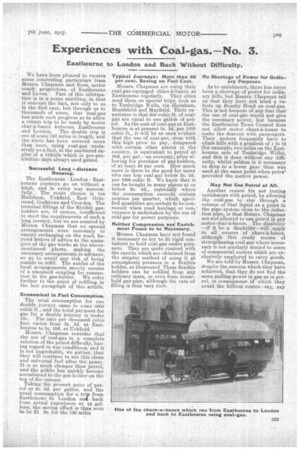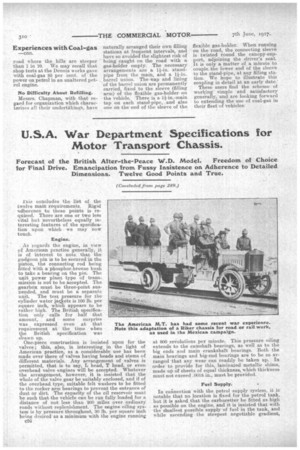Experiences with Coal-gas.--No. 5.
Page 5

Page 6

If you've noticed an error in this article please click here to report it so we can fix it.
Eastbourne to London and Back "Without Difficulty.
We have been pleased to receive some interesting particulars from Messrs.Chapman and Sons, motor coach proprietors, of Eastbourne and Lewes. Part of this infantation ia in a sense startling, in that it conveys the fact, not only to us in the first case, but through us to thousands of users, that coal-gas has made such progress as to allow a return trip to be made by motor char-à-banes between Eastbourne and London. The double trip is , one of some 130 miles in length, and the route has been covered more than once, using coal-gas exclusively as a fuel, in the unaltered engine of a vehicle which in pre-prohibition days always used petrol.
Successful Long distance Running.
The Eastbourne London Eastbourne journeys go on without a hitch, and in every way successfully. The route chosen is via Hailshain, tickfield, East Grinstead, Godstone and Croydon. The terminal fillings of the flexible gasholders are, 61 course, insufficient to Meet the .requirements of such a long journey, but we are assured by Messrs. Chapman that no special arrangements were necessary to ensure recharging on the road, beyond letters of adtice to the mama
• gars of the gas works at the abovementioned places, Making the necessary arrangements in advance, so as to avoid any risk of being unable to refill. The extent of the "local arrangements merely consist of a standard coupling for connection to the gas-holder. We refer further to the point of refilling in the last paragraph of this article.
Economical in Fuel Consumption.
The total , consumption for one double journey came to some 4000
• cubic ft., and the total payment for ,gas for a. double journey is under 18s. The rate per thousand cubic feet varies from 3s. 3d. at Eastbourne to 5s. 10d. at Uckfield.
Messrs. • Chapman consider that the use of coal-gas is a complete solution of the petrol difficulty, having regard to war conditions, and it is not improbable, we gather, that they will continue to use this clean, and universal fuel after the peace. It is so much cheaper than petrol, and the public has quickly become accustomed to the gas-holder on the top of the canopy.
Taking the present price of petrol at 2s. 6d. per gallon, and the usual consumption for a trip from Eastbourne to London an -back -from actual experience at 16 gallons, the saving effect is thus seen to be Li 2s. for the 130 miles
Typical Journeys : More than 50 per cent. Saving on Fuel Cost.
Messrs. Chapman are using their coal-gas-equipsted chars-h-bancs at Eastbourne regularly. They often send them on special trips, such as to Tunbridge Wells, via Hailshain, Heathfield and Mayfield. Their experience is that 250 cubic ft. of coalgas are equal to one gallon of petrol. As the cost of coal-gas at Eastbourne is at present 3s. 3d. per 1000 cubic ft., it will be at once evident that the use of coal-gas, even with this high price to pay, compared with certain other places in the country, is equivalent to petrol at 10e1. per gal.—an economy, after allowing for purchase of gas-holders, of at least 50 per cent. How much more is there to the good for users who can buy coal-gas below 35. 3d. per 1000 cubic ft. We know that it can be bought in many places at or below 2s. 8d., especially where the consumption exceeds certain minima per quarter, which specified quantities are certain to be consumed when road haulage or con-veyance is undertaken by the use of coal-gas For power purposes.
Neither Compression nor Enrichment Found to be Necessary.
Messrs. Chapman have not found it necessary to try to fit rigid containers to hold coal-gas under pressure. They are quite Content with the results which arc obtained from the simpler method of using it at atmospheric pressure in a flexible holder, as illustrated. These flexible holders can be refilled from any ordinary main, or even from household gas-pipe although the rate of filling is then very slow.
No Shortage of Power for Ordinary Purposes.
As to enrichment, there has never been a shortage. of poWer for ordinary hills' but Messrs. Chapman tell us that they have not tried a vehicle up Beachy Head on coal-gas. This is not because of any fear that the use of coal-gas would not give the necessary power, but because the Eastbourne Town Council does not allow motor ehars-à-banes to make the descent with passengers. Their motors frequently have to climb hills with a gradient of 1 in 12 (for example, two miles on the Eastbourne side of Tunbridge Wells), and this is done without any difficulty', whilst seldom is it necessary to drop to a lower gear than was used at the same point when petrel provided the motive power.
May Not Use Petrol at All.
,Another reason for not testing enrichment with petrol, by allowing the coal-gas. to -rise through a column of that liquid at a point in the pipe system close to the induction pipe, is that Messrs.-Chapman are not-allowed to use petrol hi any
• motor-char-h-loancs.. The disability —if it be a disability—will apply .to all owners of chars-A-banes, although this ready means tif strengthening coal-gas where necessary is not similarly denied to users of commercial Motors which are exclusively employed to carry ,goods. • We are told by Messrs. Chapman, despite the.success which they have achieved, that they do not find the same pulling power in gas as in petrol, in consequence of which they avoid. the hilliest routes—say., any road where the hills are steeper than 1 in 10. We may recall that shop tests at the Dennis works gave with coal-gas 85 per Cent. of the power on petrol in an unaltered petrol engine.
No Difficulty About Refilling.
Messrs. Chapman, with that regard for organization which characterizes all their undert6.kingt, have naturally arranged their own filling stations at frequent intervals, and have so avoided the slightest risk of being caught on the road with a gas-holder empty. The necessary arrangements are a 1i-in. standpipe from the main, and a if barrel union. The -cap and lining of the barrel union are permanently carried, fixed to the sleeve (filling arm) of the flexible gas-holder on the vehicle. There is a 1i-in.-main tap on each stand-pipe, and also one on the end of the sleeve of the flexible gas-holder. When running on the road, the connecting sleeve is twisted round the canopy-support, adjoining the driver's seat. It is only a matter of a minute to couple, the lower end of the sleeve to the stand-pipe, at any filling station. We hope to illustrate this coupling in detail at an early date. These users find the scheme of working simple and satisfactory generally, and are looking forward to extending the use of coal-gas in their fleet of vehicles:




















